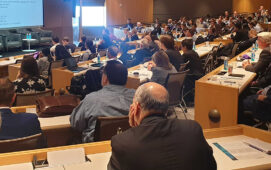The European Central Bank (ECB) might be keen for harmonisation across the European securities settlement environment, but it is not fussy about how it gets there, said Hugh Simpson, senior advisor to the central bank from Bourse Consult at this week’s CorpActions 2011 conference in London. One important prerequisite to harmonisation is (whether it be via Target2-Securities or otherwise), however, is the adoption of new standards, including those identified by the ECB’s Corporate Actions Sub-group (CASG) in the corporate actions space.
The responsibility for the adoption of these new corporate actions standards has been laid at the feet of the central securities depositories (CSDs) who will be compelled to adopt them as they sign up to participate in T2S, explained Simpson. For example, in the market claims space, the message standard will have two owners: the buyer CSD and the seller CSD, both of whom will be responsible for generating and sending the messages via T2S. In the transformations space, the messages will be the remit of the clearing counterparty or the instruction owner CSD, whereas buyer protection is optional for CSDs, he added.
These CSDs will need to adopt the relevant standards by the start of 2014, ahead of the planned launch of T2S in September of that year. Simpson noted research conducted last year by the ECB that demonstrates how far the CSDs have to go to reach compliance: at that point the most advanced CSD was only 70% compliant and many were not compliant at all with the messaging standards.
In its December status report, the CASG also noted that “virtually all markets except the UK and Ireland, are not planning any automatic buyer protection mechanism at the CSD level”. The group has also previously identified three other particular areas of concern: the model for the cross border securities and cash distributions in the context of T2S; the use of T2S dedicated cash accounts for corporate actions cash payments; and the T2S night time sequencing for corporate actions instructing and processing.
“The ECB is agnostic about how a harmonised settlement environment comes about,” said Simpson. “It could be via T2S or it could be via market-wide adoption of standards for interoperability and a level playing field.”
He noted that the likely outcome of all of this work would be the introduction of the opportunity for new entrants to the CSD environment across Europe and eventual CSD consolidation. “The legal implication will also be that issuers will have much more choice in their choice of CSD rather than being forced to use their domestic CSD,” he said. “This will compel an increased focus on issuer services and asset servicing in general, including corporate actions.”
Subscribe to our newsletter




